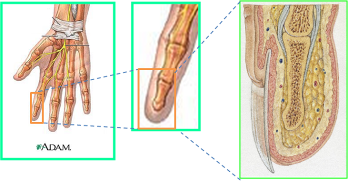ORGAN ENGINEERINGOne of the most costly and destructive problems in human healthcare is the loss of the tissues, leading to organ failures. Organ transplantation, autologous tissue transfer, and mechanical devices utilized to remedy this problem have not been so far able to provide a permanent solution.
Thanks to the development of third-generation (smart) biomaterials, engineering of organs can now be attempted by employing the strategies used for the engineering of individual tissues forming the complex structure.
In this regard, a biomimetic multiphasic scaffold fabrication technology could be very appropriate for the engineering of complex tissues such as finger, which is composed of layers of multiple tissues (Fig-1). Each layer of the concentric scaffold system could be designed to possess tissue-relevant architecture with continuous transitions of properties, and be enriched with signaling molecules to modulate the differentiation of stem cells into desired lineages.
|

|
Fig-1. Schematics of gross and macroscopic view of finger as an example of complex system. |

|
Cevat Erisken, Ph.D. |
|
TOBB University of Economics and Technology, Biomedical Engineering Department |
|
TOBB University of Economics and Technology |


